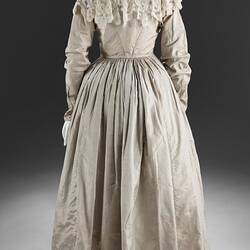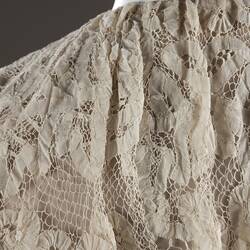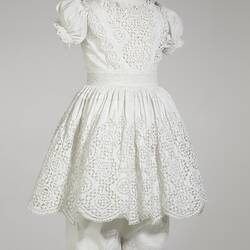Summary
Faded green silk dress with long, tight sleeves (a little loose around elbows), high neckline and Bertha lace collar. It would have been worn with a small bustle over the bottom.
According to the donor, the dress was made and used in Scotland about 1830 for the wedding of Janet Robertson and Robert Fleming. Later that year they sailed to Van Diemen's Land (later Tasmania). In 1836, Janet and Robert crossed Bass Strait to Port Phillip (later Victoria) with their two children and two ex-convict servants. They settled on the banks of the Yarra, later buying land in Collins Street in Melbourne's first land sale on 1 June 1837. Less than one week later, Janet gave birth to another son. She gave birth to six more children, of whom four died before the age of three. She died at the age of 47, in 1856. Robert Fleming grazed sheep on the land that is now Flemington Racecourse.
Although dated to 1830, the dress clearly has the appearance of an early 1840s style - particularly the long, pointed bodice and tightened sleeves. While the dress may have been altered to update its appearance, it is unlikely that the straight waistline of the 1830s has been replaced by the pointed bodice of the 1840s.
Physical Description
Faded green silk dress with long, tight sleeves, high neckline and Bertha lace collar. Hand-sewn (with recent machine-stitched repairs by conservators.) Bodice has a low pointed front, and is cut on the straight (rather than the bias, which uses more fabric but creates a neater fit), and double piping. The skirt is made from seven panels, possibly from a narrow cloth. It measures about 3.5 metres diameter. It is gathered into the waistline. The collar has been added later, and was made for a dress with a wider neckline.
Significance
These objects relate to immigration and cultural diversity as they are part of the story of one family's immigrtion to Australia. The wedding dress is an example of an object considered precious enough to bring to Australia. It is believed to have last been worn circa 1958.
Note: the straight upper sleeves of this dress are not appropriate for an 1830 dress. They may have been altered, or the dress may be later - perhaps 1840s. Annette Soumilas, historic clothing fitting specialist, thinks the dress has the appearances of a garment made in the late 1830s - rather than 1830 or prior, as the provenance suggests. The double-piping of the bodice is typical of this period - and earlier. She notes that it was a very modest garment (by the 1820s modesty was coming back into fashion). The skirt is made from seven panels, possibly from a narrow cloth. It measures about 3.5 metres diameter. The bertha collar was originally used on a dress with a lower neckline.
More Information
-
Collecting Areas
-
Acquisition Information
Donation from Ms Barbara Brown, 15 Feb 1999
-
Place & Date Made
Scotland, Great Britain, circa 1830
Elements of style suggests it was actually made in the early 1840s. -
Place & Date Used
Scotland, Great Britain, 1830
According to donor -
Place & Date Used
Victoria, Australia, 1836 or later
According to donor -
Past Owner
-
User
-
Classification
-
Category
-
Discipline
-
Type of item
-
Exhibition Collection Management
1440 mm (Length), 1650 mm (Width), 300 mm (Depth)
Centre waist to hem 890;
-
Overall Dimensions
3500 mm (Circumference)
Skirt measurement, calculated by Annette Soumilas, historic clothing fitting specialist.
-
References
Information on the dress's provenance supplied by the donor. Dresses of the 1840s of a similar appearance to the Fleming dress are depicted in the 1840s chapter of Dressed for the Photographer: Ordinary Americans and Fashion, 1840-1900. Joan Severa, Kent State University Press, 1995. Fleming, B., 2021. Edinburgh to Mia Mia: The Story of Robert and Jessy Fleming.
-
Keywords
Handcrafts, Needlework, Settlement, Scottish Immigration, British Immigration, Migration & Settlement, Racecourses, Marriage Customs & Rites






